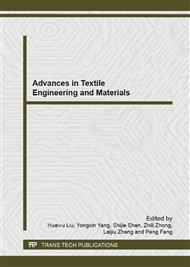p.105
p.110
p.117
p.122
p.125
p.130
p.138
p.143
p.147
The Influence of Acrylic Acid Irradiation Grafting to the Hydrophilicity of Polypropylene Spunbonded Nonwovens
Abstract:
The acrylic acid was used as hydrophilic agent, the graft copolyreaction of acrylic acid and polypropylene was occurred under electron beam irradiation to modify the hydrophilicity of the polypropylene spunbonded nonwovens. The influenced of acrylic acid concentration and the irradiation dose to the hydrophilic properties were studied. The results show that for a constant irradiation dose, when the acrylic acid concentration is between 2 % and 10% , the grafting rate and the hydrophilic properties of the polypropylene spunbond nonwovens is first increased and then decreased , and reaches a maximum at the 8%. For a constant acrylic acid concentration, when the irradiation dose is between 10kGy and 50kGy, the grafting rate and the hydrophilic properties of the polypropylene spunbond nonwovens is also first increased and then decreased , and reaches a maximum at the 40kGy. The breaking strength increased with the increasing of the grafting rate, but decreased with the increasing of the irradiation dose
Info:
Periodical:
Pages:
125-129
Citation:
Online since:
December 2012
Authors:
Price:
Сopyright:
© 2013 Trans Tech Publications Ltd. All Rights Reserved
Share:
Citation:


